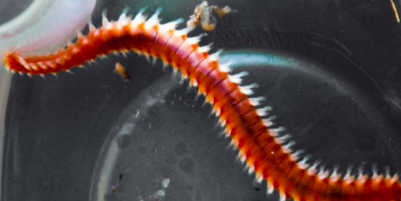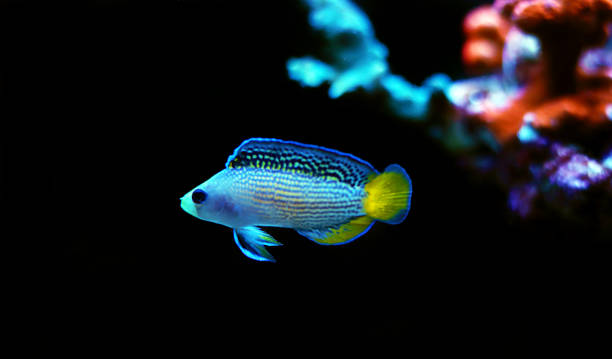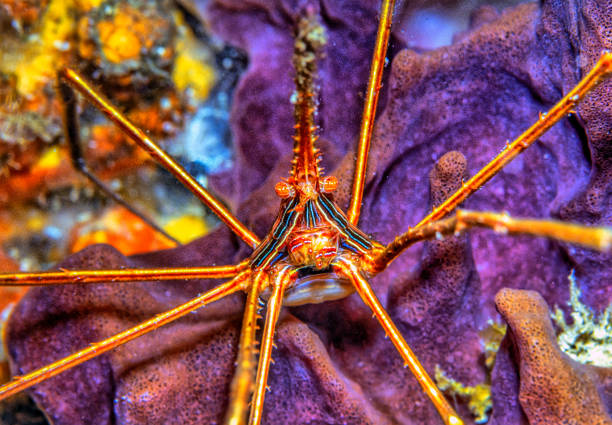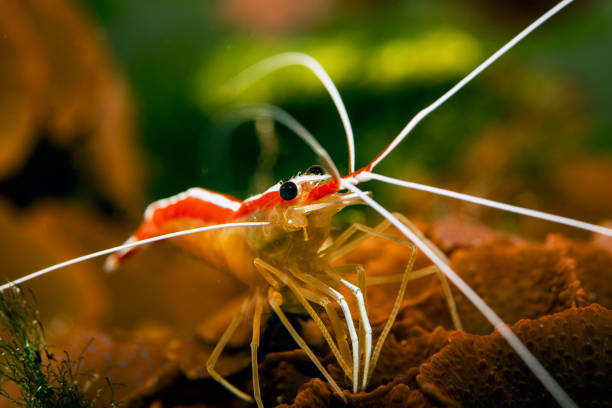Introduction to Bristle Worms
Understanding what eat bristle worms is crucial for maintaining a healthy aquarium. Bristle worms are segmented marine worms found in saltwater environments, and they are common inhabitants of reef tanks. These worms are often recognized by their bristles or setae, which can cause irritation if touched.
While some aquarium owners view bristle worms as pests, they can actually play a beneficial role in the tank’s ecosystem. Bristle worms help break down detritus and uneaten food, effectively aiding in the decomposition process. However, an overpopulation of bristle worms can become problematic, leading to concerns about what eat bristle worms to control their numbers naturally.
Several fish species, such as wrasses and dottybacks, are known to consume bristle worms, making them valuable allies in keeping bristle worm populations in check. In addition to fish, certain invertebrates like coral banded shrimp and arrow crabs also prey on bristle worms.
It’s essential to properly identify bristle worms to determine their impact on your aquarium and to decide on appropriate control measures if necessary. Correctly balancing the population of what eat bristle worms can enhance the overall health and stability of your reef tank.
What Are Bristle Worms?
Bristle worms are a type of polychaete worm frequently found in marine aquariums. These segmented worms are distinguished by bristles, or setae, which line their bodies. Understanding what eats bristle worms is crucial for controlling their population in your tank. Bristle worms are typically detritivores, meaning they feed on decomposing organic material.
They play a beneficial role in cleaning the tank by consuming leftover food and waste. However, their presence can become problematic if their population grows unchecked. Some species of bristle worms, like fireworms, can be harmful to other marine life. Fireworms have venomous bristles that can sting both humans and fish, causing irritation.
Bristle worms generally hide in the substrate or within live rocks in the aquarium. They usually come out at night to scavenge for food, making them less visible during the day. The average bristle worm can range in size from a few millimeters to several inches. Knowing what eats bristle worms can help maintain a balanced aquarium ecosystem.
In summary, bristle worms are both beneficial and potentially harmful, depending on their population size and species. Monitoring your tank and understanding the role of bristle worms can help in maintaining a healthy marine environment.

Identifying Bristle Worms
What eat bristle worms is a common question among aquarium enthusiasts who want to maintain a healthy tank environment. Identifying bristle worms is crucial for understanding whether or not you need to take action. Bristle worms are segmented, elongated worms that belong to the Polychaeta class. They can range in color from translucent white to bright pink, red, or even iridescent blue.
One of their distinctive features is the presence of tiny bristles, called chaetae, along their body segments. These bristles are often used for locomotion and can cause irritation if touched. Bristle worms typically hide in the substrate or within the live rock in your aquarium. They often come out at night or when the tank lights are dimmed, making them easier to spot during these times. Small holes or tubes in the live rock can often be an indicator of bristle worm activity.
Another sign of bristle worms in your tank is their rapid movement when disturbed. They can move quickly to find new hiding spots, making them challenging to catch. If you notice any of these signs, it’s a good idea to investigate further to confirm their presence. Knowing how to identify bristle worms helps you determine the next steps, including considering what eat bristle worms to keep their population under control.
When examining bristle worms closely, you may observe that some species can grow quite large, up to 10 inches or more in length. However, most species found in home aquariums are usually much smaller. By understanding these characteristics, you can accurately identify bristle worms and decide whether they are friend or foe in your aquarium.
Are Bristle Worms Harmful?
The question of whether bristle worms are harmful is a crucial one, especially when considering what eat bristle worms in aquarium settings. Bristle worms are generally not harmful to most reef tank inhabitants, including corals and fish. Their main function is acting as part of the clean-up crew, consuming detritus and uneaten food, thus maintaining tank health.
However, certain species of bristle worms, such as fireworms, can be harmful. Fireworms possess toxin-laden bristles that cause painful stings to both humans and fish. In large populations, even non-toxic bristle worms can become a nuisance. They might compete with other beneficial organisms for resources, leading to an imbalance in the aquarium’s ecosystem.
So, what eat bristle worms in this case? Predators like wrasses, dottybacks, and arrow crabs can help to naturally control bristle worm populations. Additionally, bristle worms can sometimes cause indirect harm. Their burrowing activity can lead to structural issues in live rock and substrate. Careful monitoring and proper tank maintenance can mitigate these risks.
In summary, while bristle worms can be beneficial in small numbers, it’s important to manage their population for a balanced and thriving aquarium. It’s crucial to know what eat bristle worms to maintain a balanced ecosystem in your tank.

Benefits of Bristle Worms in Aquariums
When discussing what eat bristle worms, it’s also essential to understand their benefits in aquariums. Bristle worms play a crucial role in maintaining a balanced and clean aquarium environment. These worms are excellent scavengers, consuming leftover food, detritus, and other organic matter that settles on the substrate. By doing so, bristle worms help in preventing the buildup of harmful substances like ammonia and nitrate.
Their presence leads to a more efficient waste breakdown, which can improve overall water quality and reduce the need for frequent clean-ups. In addition to cleaning up detritus, bristle worms also engage in bioturbation. This process involves the stirring and aeration of the substrate, which promotes better oxygenation and nutrient distribution. Consequently, healthy bacteria can thrive, contributing to a more stable and thriving reef aquarium ecosystem.
Some aquarium enthusiasts even consider bristle worms as a natural form of biological filtration. Their constant feeding activity ensures that leftover food particles don’t decay and pollute the tank. For aquarists who are concerned about what eat bristle worms, it’s worth noting that managing bristle worm populations can be beneficial rather than attempting to eradicate them.
Balanced bristle worm populations contribute to the overall health of the aquarium without posing any serious threats to fish or corals. By understanding these benefits, aquarists can better appreciate the role of bristle worms and take more informed actions on maintaining a healthy tank ecosystem.
While it’s crucial to manage their numbers, bristle worms offer numerous advantages that should not be overlooked. Are there concerns about bristle worm overpopulation? Not necessarily, if there are adequate natural predators. By keeping a well-balanced tank, aquarists can enjoy all the positive aspects bristle worms bring to their aquatic environment.
Natural Predators of Bristle Worms
When it comes to managing what eat bristle worms, understanding their natural predators is crucial. Certain fish species, like wrasses and dottybacks, are known for their appetite for bristle worms. Wrasses, particularly the six-line wrasse, are effective predators that can help control bristle worm populations. Dottybacks are another group that will readily consume bristle worms, making them valuable for reef tank enthusiasts.
In addition to fish, some invertebrates, such as arrow crabs and coral banded shrimp, also prey on bristle worms. Arrow crabs are particularly proficient at capturing and consuming bristle worms due to their long, clawed appendages. Coral banded shrimp, though usually more passive, will take the opportunity to consume smaller bristle worms if available. Introducing these natural predators can be an efficient way to manage bristle worm populations in a saltwater aquarium.
However, it is important to ensure that the added species are compatible with the existing tank inhabitants to maintain a balanced ecosystem. Always research the specific needs and behaviors of these predator species before introducing them to your aquarium to avoid unforeseen issues.

Fish That Eat Bristle Worms
Understanding what eat bristle worms is crucial for maintaining a healthy aquarium environment. Several fish species have a natural diet that includes bristle worms, helping control their population. Among these, wrasses and dottybacks are particularly notable for their efficacy in consuming bristle worms.
Wrasses are a popular choice for what eat bristle worms. Species such as the Melanurus Wrasse and the Six-Line Wrasse are known for their voracious appetite for bristle worms. They actively hunt and consume these worms, making them an excellent addition to any reef aquarium looking to keep bristle worms under control.
Dottybacks are another group of fish that eat bristle worms. The Orchid Dottyback and the Neon Dottyback are examples that prey on bristle worms. These colorful and hardy fish can help significantly reduce bristle worm populations in a reef tank.
While not as common, some larger predatory fish like certain species of Pufferfish also eat bristle worms. However, their suitability depends on the compatibility with other tank inhabitants and the aquarium size. Pufferfish are best considered for larger, more robust tank environments.
It’s essential to choose the right species of fish for your specific aquarium setup. Researching their compatibility with other tank mates and the tank’s size is vital. In summary, wrasses and dottybacks are the primary fish that eat bristle worms, offering a natural method to control these worms’ population in your aquarium. Selecting the right predatory fish can maintain a balanced ecosystem, contributing to the overall health and well-being of your aquatic environment.

Wrasses
Wrasses are one of the primary fish that eat bristle worms, making them a natural and effective predator in your aquarium. These colorful fish are not only visually appealing but also serve a functional role in maintaining the health of your tank ecosystem.
Several species of wrasses are known for their bristle worm consumption. The Melanurus Wrasse, for example, is particularly effective and popular among aquarium enthusiasts. These fish actively hunt and eat bristle worms, helping to control their population and prevent potential outbreaks.
Wrasses are also known for their versatility and adaptability to different tank conditions. They can coexist peacefully with other marine species, making them a suitable addition to most reef aquariums. Apart from eating bristle worms, they also consume other problematic pests like flatworms and small crustaceans.
It’s essential to provide a suitable environment for wrasses to thrive. A well-maintained tank with plenty of hiding spots and live rock will meet their natural behaviors and dietary needs. Regular feeding with a varied diet, including meaty foods, will ensure they remain healthy and active.
Keep in mind that wrasses may occasionally target other invertebrates in your tank. While they primarily focus on bristle worms, they might also nip at small snails and shrimp. Monitoring their behavior and adjusting your tank setup can help mitigate any unintended consequences.
In summary, wrasses are a highly recommended choice for anyone looking to control bristle worm populations naturally. Their combination of beauty and functionality makes them a valuable addition to any reef aquarium.

Dottybacks
When it comes to what eat bristle worms, Dottybacks are one of the top choices. These vibrant and fascinating fish are known for their predatory behavior, making them effective natural control agents for bristle worm populations.
Dottybacks are small, colorful marine fish often found in coral reefs. They are part of the Pseudochromidae family and are prized in saltwater aquariums for their striking appearance. Their colors can range from bright yellows to deep purples, adding visual appeal to any tank.
Dottybacks have an aggressive temperament, which aids in their effectiveness as predators. They actively hunt down bristle worms hiding in the substrate or within live rock. Their sharp, pointed mouths enable them to capture and consume these worms efficiently.
One popular species within this category is the Orchid Dottyback. Known for its bright purple hue, the Orchid Dottyback is both beautiful and functional. It helps maintain a balanced ecosystem by keeping bristle worm populations in check.
Another notable species is the Neon Dottyback, which is equally colorful and effective at hunting bristle worms. While Dottybacks are beneficial for controlling unwanted pests, they can also exhibit territorial behavior. It’s essential to consider tank mates when introducing Dottybacks to ensure they do not harass more peaceful fish. Providing plenty of hiding spots and sufficient space can help manage their aggression.
Dottybacks are relatively hardy fish, making them suitable for both novice and experienced aquarium keepers. They require a well-maintained environment with stable water conditions. Feeding Dottybacks a varied diet will enhance their overall health. Besides preying on bristle worms, they enjoy meaty foods like brine shrimp, mysis shrimp, and other marine-based proteins.
In conclusion, Dottybacks are a fantastic option for those seeking fish that eat bristle worms. Their aggressive but manageable behavior, combined with their natural predatory instincts, make them an ideal addition to many saltwater aquariums. By incorporating Dottybacks into your tank, you can effectively reduce bristle worm infestations while adding a splash of color to your underwater world.

Arrow Crabs and Other Invertebrates
What eat bristle worms is a common question among saltwater aquarium enthusiasts, and the answer often points to arrow crabs and other invertebrates. Arrow crabs, known for their long, slender legs and distinctive arrow-shaped bodies, are natural predators of bristle worms. These crabs can reach into crevices and small spaces where bristle worms commonly hide, effectively reducing their population.
In addition to arrow crabs, certain shrimp species like Coral Banded Shrimp also prey on bristle worms. These shrimp are particularly effective because they are active hunters and can continuously control the bristle worm population. Other invertebrates, such as hermit crabs, have been known to eat smaller bristle worms, although they are less consistent in doing so.
Invertebrates like these serve a dual purpose by not only helping to eliminate bristle worms but also contributing to the overall health and cleanliness of the aquarium. Their natural behavior of scavenging and preying on bristle worms makes them an excellent addition to tanks facing overpopulation issues. While arrow crabs and these invertebrates are beneficial for controlling bristle worms, it’s essential to monitor their interactions with other tank inhabitants to ensure a balanced and peaceful environment.

Coral Banded Shrimp
Coral Banded Shrimp, commonly known as Stenopus hispidus, are excellent invertebrates to control what eat bristle worms in your aquarium. These shrimp are efficient predators, making them suitable for managing bristle worm populations. Their bright red and white bands not only add visual appeal but also signify their role as effective cleaners.
Coral Banded Shrimp actively hunt bristle worms, using their strong pincers to catch and consume them. This shrimp species is also known for its ability to feed on smaller pests, helping to maintain a healthy aquarium environment. However, it is crucial to ensure that the shrimp are in a tank with compatible tank mates. They can sometimes be aggressive towards other shrimp or small fish, especially when improperly housed.
To optimize their efficiency in controlling bristle worms, place Coral Banded Shrimp in tanks with ample hiding spots and minimal competition. Maintaining a peaceful aquarium will allow them to forage and hunt more effectively, ensuring successful bristle worm management.
Coral Banded Shrimp are thus a valuable addition to your reef tank, providing both pest control and a striking visual element. By including Coral Banded Shrimp in your aquarium, you enhance both the aesthetics and functionality of your aquatic ecosystem.

Methods to Control Bristle Worm Population
What eat bristle worms is a common question among aquarium hobbyists concerned about their tank’s ecosystem. Understanding how to control the population of bristle worms is crucial for maintaining a healthy aquarium environment. Several methods can be employed to manage these critters.
Manual Removal
Manual removal is a direct method to control bristle worm populations. Using tweezers or specialized traps, aquarists can physically remove worms. Handle them with care, as their bristles can cause irritation.
Introducing Natural Predators
One effective strategy is to introduce natural predators that eat bristle worms. Fish such as wrasses and dottybacks are known for their ability to keep bristle worm populations in check. Additionally, invertebrates like Arrow crabs and coral banded shrimp can provide natural bristle worm control.
Using Traps
Traps are another popular method for reducing bristle worm numbers. Commercial traps are available, or you can make DIY traps using simple materials. These traps attract and capture the worms, making them easy to remove from the tank.
Combining these methods can offer a comprehensive approach to control bristle worm populations in your aquarium. For more detailed insights and practical tips, keep exploring our resources at The Goldfish Tank.

Conclusion
Understanding what eat bristle worms is crucial for maintaining a balanced aquarium ecosystem. Bristle worms, though often perceived as pests, play a beneficial role by cleaning up detritus and uneaten food. However, controlling their population is necessary to prevent any potential harm to your aquarium. Methods like manual removal, traps, and introducing natural predators such as certain fish, shrimp, and crabs, offer effective solutions.
By employing these strategies, you can ensure a healthy environment for your goldfish and other aquatic creatures. Stay informed and vigilant about the inhabitants in your aquarium to make sure each species thrives. Implementing these practices will not only manage bristle worm populations but also contribute to the overall wellbeing of your marine life. For any aquarium enthusiast at The Goldfish Tank, addressing what eat bristle worms is an essential part of expert reef-keeping.
